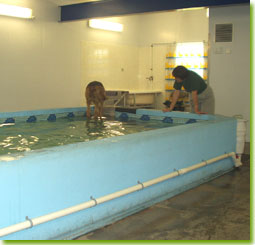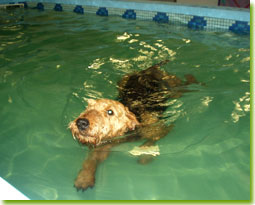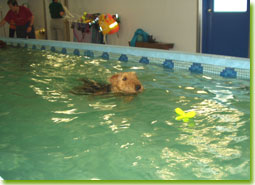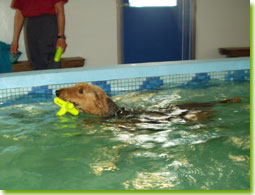
|
If this type of exercise is good for humans, then it certainly must be beneficial for dogs as well. I compete in agility with my Airedales and find my biggest challenge is how to keep them in condition during the winter months. My canine athletes needed a form of exercise that would keep them toned and conditioned to compete each spring in Agility. My agility coach, Anette Hoegl and K9 Puddle in Milton, Ontario solved my problem. Anette had an indoor pool designed for dogs and constructed on her property. It measures 40 feet in length and 8 feet in width and has a constant depth of 4 feet. The temperature is kept at 79 degrees Fahrenheit and is lightly chlorinated (this is wonderful for those us of us who are trying to keep furnishing). The pool is on ground (half submerged). This allows for interaction between you and your dog while the dog is swimming, and means you can reach your dog without having to bend down into the pool. Dogs can be encouraged and directed easily at waist height.
Once the dog is in the water, a double lead encourages the dog to paddle. The owner holds one lead on one side of the pool and Anette holds the other lead on the other side of the pool. By using two leads, the dog can be encouraged to swim lengths and to swim on one side of the pool, instead of taking up the entire pool. Once the dog understands the concept of lane swimming, the dog needs to learn how to turn around and change directions in the pool. Again the double lead, encouragement and the enticement of a favourite toy makes the learning process move quickly.
Rest times are just as important as swimming time, so owners must keep a good eye on the clock. Within a few sessions the dog is able to share the pool with a second dog. Owners are quickly transformed into cheerleaders for their dogs and their enthusiastic encouragement make the event fun and rewarding for the dog. Many dog owners eventually decide to share the cost of pool usage and form teams. The dogs soon develop “swim-friends”. Experienced dogs often share the pool with three swim-buddies. The dogs swim in their lanes with a separation of about fifteen feet. Some owners train as I do to keep their dogs in shape. Others train physically disabled dogs, who are unable to enjoy other forms of exercise. Some owners use the pool to introduce their water retriever dogs to the art of water retrieving.
In the very beginning she started out swimming for two minutes and resting for two minutes. This gradual increase in time prevents injury. Sage, my 10 year old, has a different type of program. She swims to maintain muscle tone and to avoid the stress of traditional exercise. She has built up to 10 minutes swimming and a two minute rest, followed by another 10 minute swim. She doesn’t swim with the same speed as Caye. Her purpose for swimming is for the joints and muscle tone.
Both dogs benefit greatly from their swimming programs and I would highly recommend this exercise for all dogs.
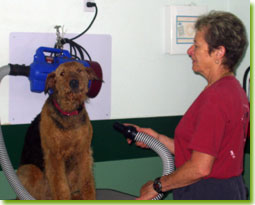
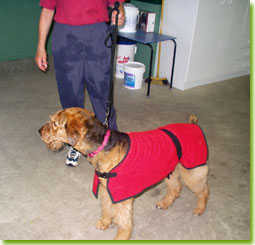
Drying off after a good swim For more information regarding K-9 Puddles and aquatic fitness for your dog please call Anette Hoegl at 905-319-1652. For members outside of the province, I suggest you contact your local agility group or obedience club and ask for a referral to a canine or equestrian theraphy pool. If you have any questions, please drop me a note at cayenne@sympatico.ca.
Photos courtesy of Karen Green
What's New |
About the ATCC |
About the Airedale Terrier |
News and Events Questions? E-mail info@airedaleterrier.ca |
